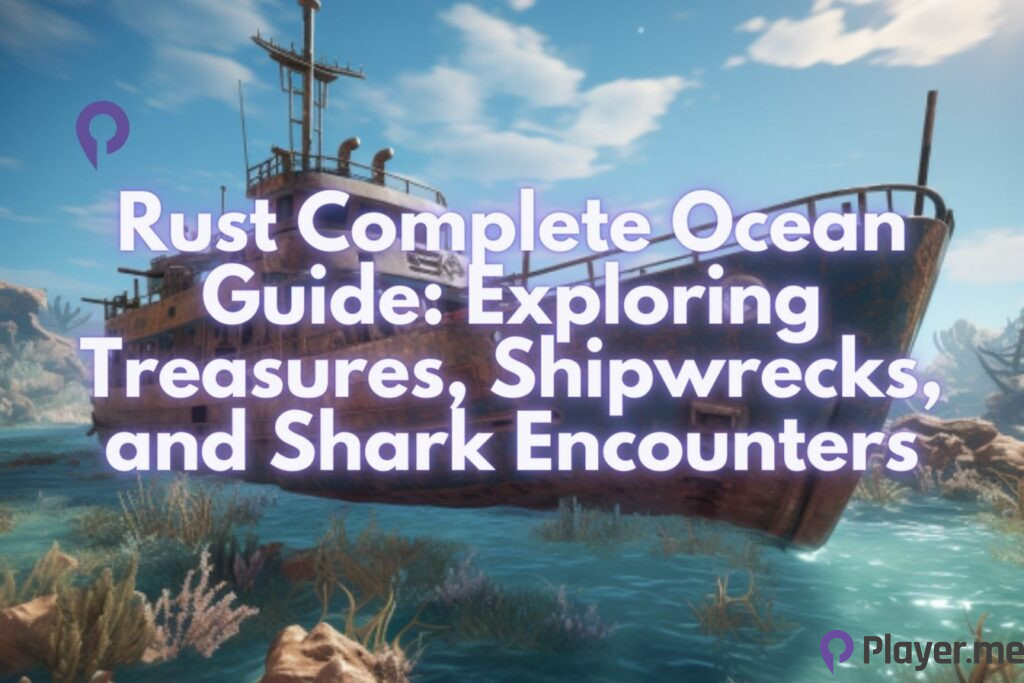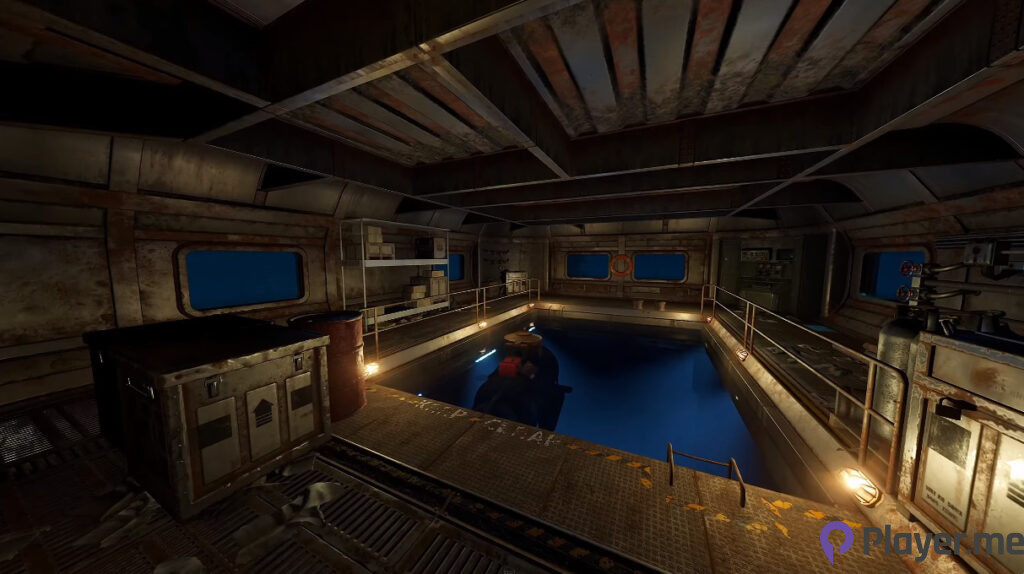
The oceans in Rust envelop the island in all directions: East, North, South, and West. From wipe to wipe, the oceans and their loot remain a constant presence. But what exactly can you discover in Rust’s oceans?
Today, we’ll delve into the mysteries of the ocean: From sunken shipwrecks to lurking sharks, along with valuable insights into scrap farming. So, let’s get started.
What You’ll Find on Rust’s Oceans
Rust’s oceans offer more than just water — there’s valuable loot and navigable routes.
Understanding how to leverage ocean resources is crucial. Rust’s oceans provide a straightforward and secure source of scrap metal compared to risky road ventures.
Exploring Rust’s Oceans
The ocean is a core aspect of Rust’s map generation. It serves as a seamless route for island-wide movement. Key landmarks, like oil rigs and underwater labs, are anchored in these oceans.
Locating Rust’s Ocean
To find the ocean, consult your map (Default key: G) and locate the island’s perimeter in any direction.
Destinations on Rust’s Ocean
Navigate the ocean to access various sites:
- Oil Rigs (Small and large)
- Rust Island
- Underwater Labs
- The Cargo Ship
Choosing Between Swimming and a Boat in Rust’s Oceans?
While swimming is an option, it’s not recommended. Opt for a motorboat or an inflatable motorised boat (RHIB) for speed, or equip diving gear (Fins) for swifter underwater movement.
Fueling Your Boat in Rust
Power your boat with low-grade fuel, obtainable by hunting animals for their resources or refining oil. Additionally, you can purchase it at the outpost.
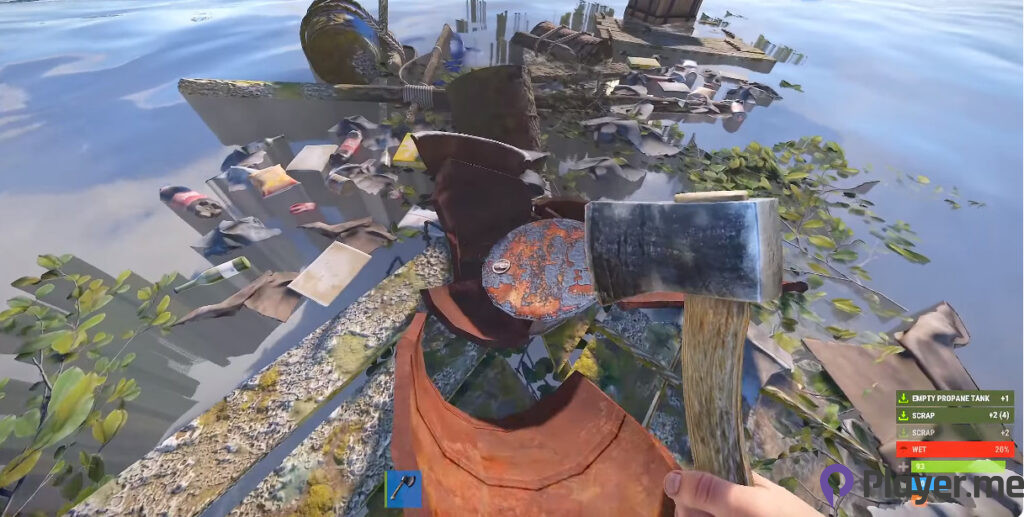
Also Read: Rust 2023 Gunplay Update: Exploring New Recoil Patterns and Mechanics
Ocean Piles
Ocean piles, often referred to as floating junk piles, are scattered throughout the ocean’s expanse. These intriguing formations harbour a variety of items, including normal barrels, oil barrels, crates, and toolboxes. To reach them more swiftly, consider equipping yourself with a small motorboat or a pair of flippers. These piles offer a more secure method of scavenging compared to the perilous roads, where unexpected encounters can catch you off guard.
Looting 30 junk piles yielded:
- 35 normal barrels
- 17 oil barrels
- 4 crates
- 14 toolboxes
Diving Sites
Diving sites, concealed beneath the water’s surface, can be identified by the presence of a floating bottle. These sites often unveil captivating sunken ships and unique underwater rock formations. However, before venturing into the depths, make sure you’re adequately equipped for the underwater adventure. Essential gear includes a diving tank, diving fins, a wetsuit, and goggles. Acquiring these items is possible by looting crates or purchasing them from the fishing village shopkeeper.
- Diving tank: 35 scrap
- Optional gear (Diving fins, wetsuit, goggles): 60 scrap
- Total cost: 95 scrap
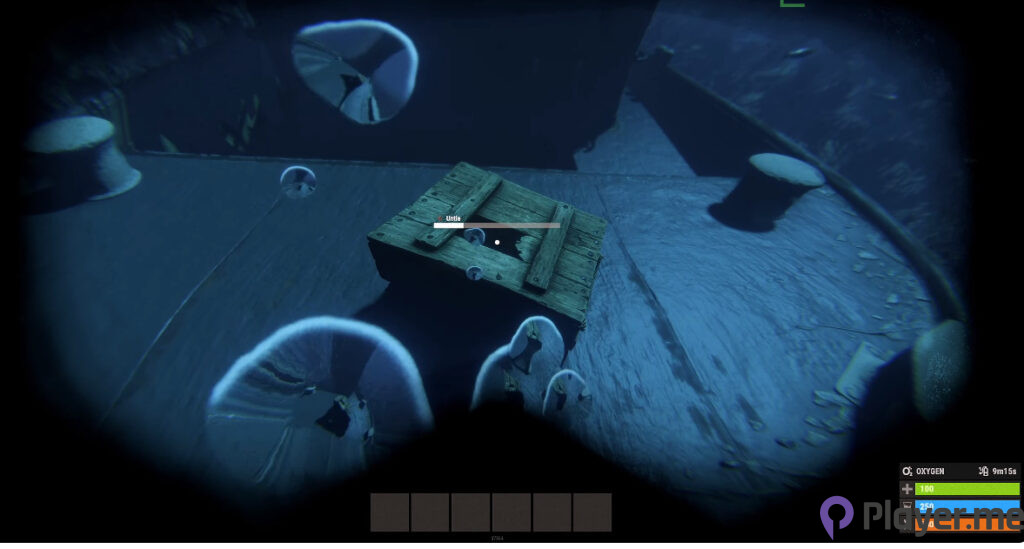
Sunken Shipwrecks
Within the ocean’s abyss lie three distinct shipwreck variations: Small ships, small overturned ships, and large ships. These shipwrecks harbour an assortment of untold treasures, concealed within tied crates and chests. To claim their contents, you’ll first need to untie these containers.
1) Small Ship
- Small ships commonly hold 1-4 sunken boxes and sunken crates.
- Before collecting the loot, you’ll need to untie the crates/boxes by pressing and holding the interact button (Usually E).
2) Large Ship
- The large ships are prized targets and less common.
- They offer a potentially richer haul, carrying as many as 7 crates/boxes.
Shipwrecks and Shark Encounters
To claim the treasures hidden within sunken crates, approach the crate and press ‘E’ to untie it. Watch as the crates ascend to the surface, eagerly awaiting your discovery. However, exercise caution, as other players might spot the floating crates and be drawn to investigate.
Larger shipwrecks prove even more promising, yielding up to seven sunken crates and chests. These substantial vessels are prime targets for loot, yet discerning their type before descending remains impossible.
- Small shipwrecks: Approximately 70 seconds for looting
- Lion’s shipwrecks: Roughly 90 seconds for looting
- Underwater rock formations: About 60 seconds for looting
Considering your oxygen supply, you can typically loot:
- Six large shipwrecks
- Eight small shipwrecks
- Ten rock formations
Also Read: The Ultimate Rust Farming and Genetics Guide
Loot and Gear from Sunken Containers
Two varieties of sunken containers exist: The sunken crate and the sunken chest. The crate, the smaller of the two, yields a more modest amount of loot. Here’s a glimpse of the significant items you can procure from a sunken crate. Notably, you’re always assured of at least five scraps.
The sunken chest, a larger container resembling a craftable large wooden box, holds a range of valuable gear, along with the guaranteed scrap loot.
Surviving Shark Encounters
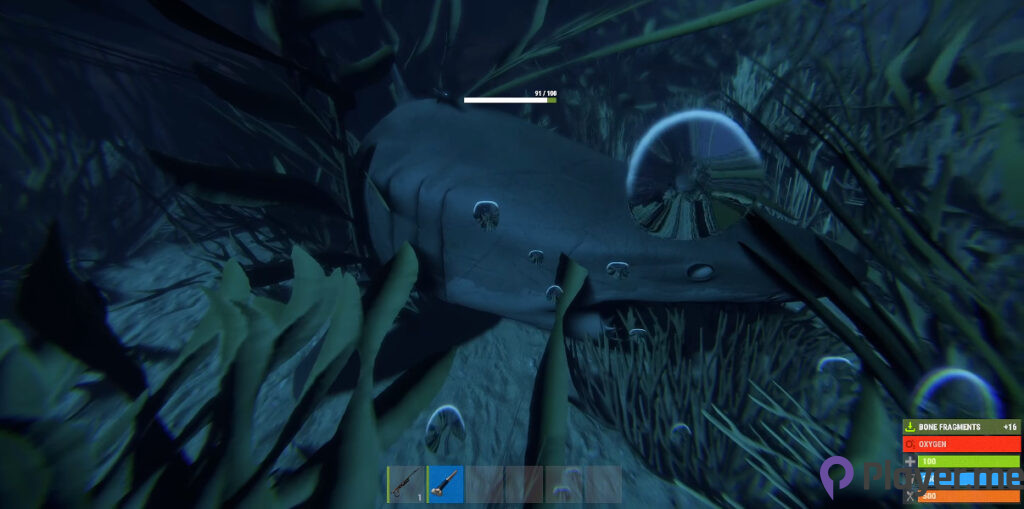
As you’re well aware, the ocean is teeming with various perilous predators, and among them, the shark is a prominent contender. These remarkable creatures can deal an average of 47 damage to those without proper protection, and they boast a health pool totalling 148. If you’re considering an encounter with them, it’s important to have the right weapons on hand and to be aware of the specific damage levels needed to effectively take them down.
Remember, melee weapon damage against sharks is halved. Despite a weapon‘s listed damage, like the hatchet’s 25 damage, its actual impact is halved, resulting in 12.5 damage. A speed gun is your ally in combating sharks, permitting you to maintain distance while delivering substantial damage. Maintain a safe distance to avoid their attacks and continue your assault.
Following a successful shark hunt, you can harvest resources from your conquest, including low-grade fuel, cloth, raw fish, leather, and bones. The harvest hinges on the tool employed for the task. This is particularly relevant for completing one of the initial fishing village missions, which rewards you with a jackhammer, medical supplies, and scrap.
Final Thoughts
Rust’s Ocean serves as an excellent location for both scrap farming and adventure. It offers a relatively easy and highly enjoyable environment to explore. This makes it an ideal choice for both beginners and experienced players alike.
Ocean piles and diving sites offer a comparatively secure avenue for looting crates, particularly when compared to venturing along roads and within monuments. Undertaking maritime expeditions is advisable for Rust novices, those residing in oceanic bases, or individuals seeking respite from losing farming equipment to rival players. However, as you delve into the depths, ensure that you are equipped with a weapon suitable for underwater use. This will help you defend against lurking threats such as sharks and other diving predators.
We hope you have enjoyed this article. Thank you for joining me in this exploration.
Also Read: 12 Essential Tips for Rust Beginners: A Guide to Getting Started
Frequently Asked Questions
Where Can Crates Be Discovered Underwater in Rust?
Crates such as sunken chests and sunken boxes are typically located in diving site regions. These crates need to be untied initially, and upon doing so, they will rise to the water’s surface. Once they’re afloat, you can open them up and collect the loot inside.
Where Can I Find a Boat for Purchase in Rust?
You can find a motorboat available for acquisition by visiting a fishing village. The cost of the motorboat is 125 scrap. It offers a convenient way to explore and navigate Rust’s waterways.
What Can I Find in Rust’s Oceans?
Rust’s oceans harbour sunken shipwrecks, floating junk piles, and diving sites. These locations offer loot, ranging from scrap to valuable gear.
Author Profile
Latest entries
 GAMING2024.06.12Top 4 Female Tekken 8 Fighters to Obliterate Your Opponents in Style!
GAMING2024.06.12Top 4 Female Tekken 8 Fighters to Obliterate Your Opponents in Style! NEWS2024.03.18Elon Musk’s SpaceX Ventures into National Security to Empower Spy Satellite Network for U.S.
NEWS2024.03.18Elon Musk’s SpaceX Ventures into National Security to Empower Spy Satellite Network for U.S. GAMING2024.03.17PS Plus: 7 New Games for March and Beyond
GAMING2024.03.17PS Plus: 7 New Games for March and Beyond GAMING2024.03.17Last Epoch Necromancer Builds: All You Need To Know About It
GAMING2024.03.17Last Epoch Necromancer Builds: All You Need To Know About It

